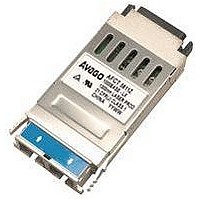AFCT-5611Z Avago Technologies US Inc., AFCT-5611Z Datasheet - Page 2

AFCT-5611Z
Manufacturer Part Number
AFCT-5611Z
Description
TXRX 1.25GBD GBIC PLUGGABLE
Manufacturer
Avago Technologies US Inc.
Datasheet
1.AFBR-5601Z.pdf
(13 pages)
Specifications of AFCT-5611Z
Applications
Ethernet
Data Rate
1.25Gbd
Wavelength
1310nm
Voltage - Supply
4.75 V ~ 5.25 V
Connector Type
GBIC
Mounting Type
Panel Mount
Supply Voltage
5V
Wavelength Typ
850nm
Peak Reflow Compatible (260 C)
Yes
Leaded Process Compatible
Yes
Optical Fiber Type
TX/RX
Optical Rise Time
0.26/0.35ns
Optical Fall Time
0.26/0.35ns
Jitter
0.227ns
Operating Temperature Classification
Commercial
Peak Wavelength
860nm
Operating Supply Voltage (min)
4.75V
Operating Supply Voltage (typ)
5V
Operating Supply Voltage (max)
5.25V
Operating Temp Range
0C to 60C
Pin Count
20
Lead Free Status / RoHS Status
Lead free / RoHS Compliant
Lead Free Status / RoHS Status
Lead free / RoHS Compliant, Lead free / RoHS Compliant
The AFBR-5601Z has been developed with 850 nm short
wavelength VCSEL technology while the AFCT-5611Z is
based on 1300 nm long wavelength Fabry Perot laser
technology.
The AFBR-5601Z complies with Annex G of the GBIC
specification Revision 5.4. In the 1000 BASE-SX environ-
ment the AFBR-5601Z achieves 220 m transmission
distance with 62.5 µm and 500 m with 50 µm multimode
fiber respectively.
The AFCT-5611Z complies with Annex F of the GBIC
specification Revision 5.4 and reaches 10 km with 9/125
µm single mode fiber. Both the AFBR-5601Z and the
AFCT-5611Z are Class 1 Eye Safe laser devices.
Serial Identification
The AFBR-56xxZ and AFCT-5611Z family complies with
Annex D (Module Definition 4) of the GBIC specifica-
tion Revision 5.4, which defines the Serial Identification
Protocol.
Definition 4 specifies a serial definition protocol. For this
definition, upon power up, MOD_DEF(1:2) (Pins 5 and
6 on the 20-pin connector) appear as NC. Pin 4 is TTL
ground. When the host system detects this condition, it
activates the public domain serial protocol. The protocol
uses the 2-wire serial CMOS E
MEL AT24C01A or similar.
The data transfer protocol and the details of the manda-
tory and vendor specific data structures are defined in
Annex D of the GBIC specification Revision 5.4.
Regulatory Compliance
See the Regulatory Compliance Table for the targeted
typical and measured performance for these transceiv-
ers.
The overall equipment design will determine the level it
is able to be certified to. These transceiver performance
targets are offered as a figure of merit to assist the de-
signer in considering their use in equipment designs.
Note: AFBR-5601Z is non-compliant for Tx fault timing.
2
2
PROM protocol of the AT-
Electrostatic Discharge (ESD)
There are two design cases in which immunity to ESD
damage is important.
The first case is during handling of the transceiver prior
to inserting it into the host system. It is important to
use normal ESD handling precautions for ESD sensitive
devices. These precautions include using grounded wrist
straps, work benches, and floor mats in ESD controlled
areas.
The second case to consider is static discharges during
insertion of the GBIC into the host system. There are two
guide tabs integrated into the 20-pin connector on the
GBIC. These guide tabs are connected to circuit ground.
When the GBIC is inserted into the host system, these
tabs will engage before any of the connector pins. The
mating connector in the host system must have its tabs
connected to circuit ground. This discharges any stray
static charges and establishes a reference for the power
supplies that are sequenced later.
Electromagnetic Interference (EMI)
Most equipment designs utilizing these high-speed trans-
ceivers from Avago Technologies will be required to meet
the requirements of FCC in the United States, CENELEC
EN55022 (CISPR 22) in Europe and VCCI in Japan.
Immunity
Equipment utilizing these transceivers will be subject to
radio-frequency electromagnetic fields in some environ-
ments. These transceivers have good immunity to such
fields due to their shielded design.
Eye Safety
Laser-based GBIC transceivers provide Class 1 (IEC 60825-
1) and Class I (US 21 CFR[J]) laser eye safety by design.
Avago Technologies has tested the current transceiver
design for compliance with the requirements listed below
under normal operating conditions and for compliance
under single fault conditions.
Outline Drawing
An outline drawing is shown in Figure 1. More detailed
drawings are shown in Gigabit Interface Converter speci-
fication Rev. 5.4.



















